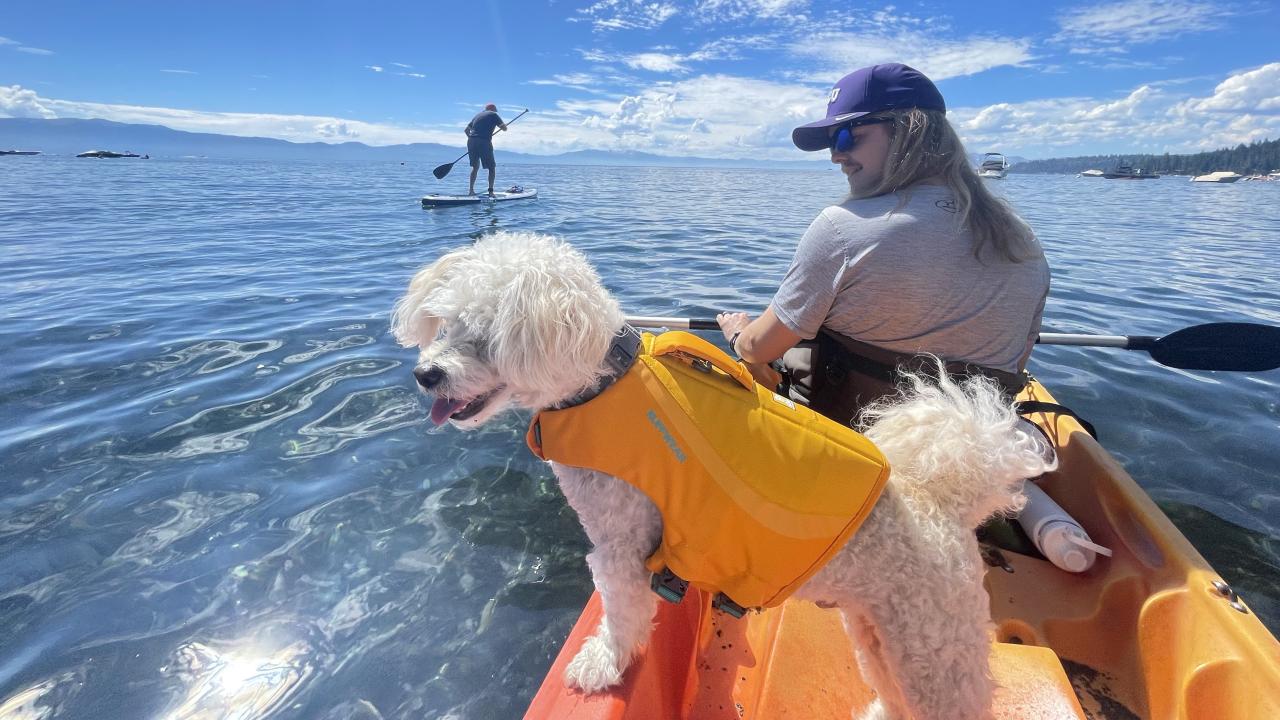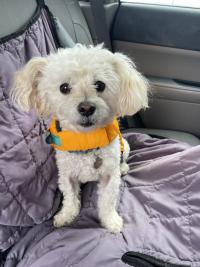
Novel Procedure Relieves Dog of Kidney Stones
“Case of the Month” – December 2023
Noodle, a 3-year-old male poodle mix, was rescued in 2020 by John and Shannon Cogswell. After noticing blood in Noodle’s urine, they took him to their primary care veterinarian who discovered an abnormality on imaging of his kidneys, most likely the formation of stones. Two years of specialist referrals, medical treatments, and diet alterations followed with no resolution to his kidney stone issue, so Noodle ultimately landed at the UC Davis veterinary hospital in late 2022.

Once at UC Davis, Noodle was in the care of Drs. Carrie Palm and Dennis Woerde, board-certified internists with special interests in urology and nephrology.
Throughout his 2-year ordeal, Noodle remained relatively healthy, and the Cogswells held out hope that the problem could be resolved medically. Surgery is not always necessary when a dog is diagnosed with kidney stones. In some cases, stones can dissolve with medical management, and in other circumstances, stones can just be monitored if they don’t appear to be interfering with normal kidney and bladder functions.
“Dr. Woerde and the team were great about exploring every avenue before surgery,” said Shannon. “We tried many different medical and diet options. They clearly weren’t working, so the best step for us to take was surgery.”
“By looking at the imaging, it was clear that it was close to a serious situation if one of those stones became dislodged and blocked his ureter or urethra,” John said.
In a similar previous case, Drs. Palm and Woerde achieved the first ever percutaneous (through the skin) removal of kidney stones in a dog. This novel procedure eliminated the need for invasive surgery, which is the current standard protocol of care in veterinary medicine. While the previous case needed lithotripsy to break down the stones before removal, Noodle’s stones were small enough to be removed without the shockwave therapy of downsizing the stones.

“Luckily, Noodle’s stones were tiny, so they didn’t need to be broken up,” said Dr. Palm, co-chief of the Internal Medicine Service. “Instead of opening his abdomen, we were confident in our ability to gain percutaneous access to the kidney with a needle and a wire and utilize a scope to pull and flush the stones out.”
So, by spring of 2023, Noodles was set to become only the second patient ever to have percutaneous stone removal surgery, and the first without initial lithotripsy. Since this was such a new procedure, there was no data on potential outcomes.
“They told us this was a very rare procedure,” John said. “That was a very emotional conversation between Shannon and I to make the decision to go ahead with the surgery.”
“Drs. Palm and Woerde, along with the entire team, did a great job of walking us through the risks and benefits of this new procedure,” Shannon said. “Their collaboration gave us a lot of confidence.”
“It was so important for us to have that confidence in the UC Davis team,” John said. “That team effort was so amazing throughout Noodle’s care – everyone sharing their expertise and discussing the different perspectives and points of view of the best approach for Noodle.”

Assisted by the Anesthesia and Diagnostic Imaging Services, Drs. Palm and Woerde were joined by Dr. Bill Culp, chief of the Soft Tissue Surgery Service, to perform Noodle’s surgery. Ultrasound was used to gain percutaneous access to Noodle’s kidney followed by the use of fluoroscopy (real time x-rays) to establish access into the kidney, where the imaging allowed guidance of a scope into the renal pelvis to remove more than 100 tiny stones. After suctioning and flushing the stones, a stent was placed from Noodle’s kidney to his bladder to help keep the ureter open to prevent any potential stone fragments from blocking his ureter.
The incision needed for the procedure was so small that the tissue closed immediately upon removal of the needle, and no sutures were needed.
Noodle was hospitalized for five nights, where he was cared for by a highly skilled team of veterinary technicians, and made a full recovery.
“We appreciated the individual attention that Noodle received during his hospitalization,” said Shannon. “His caregivers would send us videos of him taking short walks. It gave us a sense of being there with him.”
Noodle is now on a urinary/kidney health diet to hopefully stop any future stones from forming.
With two successful surgeries, Drs. Palm and Woerde look to increase the application of this new minimally invasive effort, even implementing the approach on horses. They have presented preliminary information on the procedure at one veterinary conference already and are pursuing publication of the data soon.
# # #
